Rainfall Trends and Extremes in Saudi Arabia in Recent Decades
Abstract
1. Introduction
2. Data and Methods
2.1. Data
2.2. Methods
3. Results and Discussion
3.1. Rainfall Distribution and Climatology
3.2. Rainfall Variability and Trends
3.3. Extreme Rainfall Events Frequency and Trends
3.4. Rainfall Return Period
3.5. Contribution of Extreme Rainfall to the Total Rainfall
4. Summary and Conclusions
Funding
Acknowledgments
Conflicts of Interest
References
- Easterling, D.R.; Meehl, G.A.; Parmesan, C.; Changnon, S.A.; Karl, T.R.; Mearns, L.O. Climate Extremes: Observations, Modeling, and Impacts. Atmos. Sci. Rev. 2000, 289, 2068–2074. [Google Scholar] [CrossRef] [PubMed]
- Atif, R.M.; Almazroui, M.; Saeed, S.; Abid, M.A.; Islam, M.N.; Ismail, M. Extreme precipitation events over Saudi Arabia during the wet season and their associated teleconnections. Atmos. Res. 2020, 231, 104655. [Google Scholar] [CrossRef]
- IPCC. Climate Change 2013: The Physical Science Basis. Contribution of Working Group to the 5th Assessment Report of the Intergovernmental Panel on Climate Change (IPCC); Cambridge University Press: Cambridge, UK, 2013. [Google Scholar]
- Irizarry-Ortiz, M.M.; Obeysekera, J.; Park, J.; Trimble, P.; Barnes, J.; Park-Said, W.; Gadzinski, E. Historical trends in Florida temperature and rainfall. Hydrol. Process. 2013, 27, 2225–2246. [Google Scholar] [CrossRef]
- IPCC. Climate Change 2007. Impacts, Adaptation and Vulnerability. Contribution of Working Group II to the Fourth Assessment Report of the Intergovernmental Panel on Climate Change (IPCC); Cambridge University Press: Cambridge, UK, 2007. [Google Scholar]
- Katz, R.W.; Brown, B. Extreme Events in a Changing Climate: Variability Is More Important Than Averages. Clim. Chang. 1992, 21, 289–302. [Google Scholar] [CrossRef]
- Bell, J.E.; Brown, C.L.; Conlon, K.; Herring, S.; Kunkel, K.E.; Lawrimore, J.; Luber, G.; Schreck, C.; Smith, A.; Uejio, C. Changes in extreme events and the potential impacts on human health. J. Air Waste Manag. Assoc. 2018, 68, 265–287. [Google Scholar] [CrossRef] [PubMed]
- Almazroui, M.; Islam, M.N.; Athar, H.; Jones, P.D.; Rahman, M.A. Recent climate change in the Arabian Peninsula: Annual rainfall and temperature analysis of Saudi Arabia for 1978–2009. Int. J. Climatol. 2012, 32, 953–966. [Google Scholar] [CrossRef]
- Saudi Arabia Population 1960–2019 Data. Available online: https://tradingeconomics.com/saudi-arabia/population (accessed on 9 September 2020).
- Sung, J.H.; Chung, E.S.; Lee, B.; Kim, Y. Meteorological hazard assessment based on trends and abrupt changes in rainfall characteristics on the Korean peninsula. Theor. Appl. Climatol. 2015, 127, 305–326. [Google Scholar] [CrossRef]
- Bari, S.H.; Rahman, M.T.U.; Hoque, M.A.; Hussain, M.M. Analysis of seasonal and annual rainfall trends in the northern region of Bangladesh. Atmos. Res. 2016, 176, 148–158. [Google Scholar] [CrossRef]
- Wang, X.-J.; Zhang, J.-Y.; Ali, M.; Shahid, S.; He, R.-M.; Xia, X.-H.; Jiang, Z. Impact of climate change on regional irrigation water demand in Baojixia irrigation district of China. Mitig. Adapt. Strateg. Glob. Chang. 2016, 21, 233–247. [Google Scholar] [CrossRef]
- Goswami, B.N.; Venugopal, V.; Sengupta, D.; Madhusoodanan, M.S.; Xavier, P.K. Increasing trend of extreme rain events over India in a warming environment. Science 2006, 314, 1442–1444. [Google Scholar] [CrossRef]
- Rajeevan, M.; Bhate, J.; Kale, K.D.; Lal, B. High resolution daily gridded rainfall data for the Indian region: Analysis of break and active monsoon spells. Curr. Sci. 2006, 91, 296–306. [Google Scholar]
- Gao, X.; Peng, S.; Wang, W.; Xu, J.; Yang, S. Spatial and temporal distribution characteristics of reference evapotranspiration trends in Karst area: A case study in Guizhou Province, China. Meteorol. Atmos. Phys. 2016, 128, 677–688. [Google Scholar] [CrossRef]
- Ongoma, V.; Chen, H. Temporal and spatial variability of temperature and rainfall over East Africa from 1951 to 2010. Meteorol. Atmos. Phys. 2017, 129, 131–144. [Google Scholar] [CrossRef]
- Hag-elsafi, S.; El-Tayib, M. Spatial and statistical analysis of rainfall in the Kingdom of Saudi Arabia from 1979 to 2008. Weather 2016, 71, 262–266. [Google Scholar] [CrossRef]
- Nashwan, M.S.; Shahid, S.; Abd Rahim, N. Unidirectional trends in annual and seasonal climate and extremes in Egypt. Theor. Appl. Climatol. 2019, 136, 457–473. [Google Scholar] [CrossRef]
- Nashwan, M.S.; Shahid, S. Spatial distribution of unidirectional trends in climate and weather extremes in Nile river basin. Theor. Appl. Climatol. 2019, 137, 1181–1199. [Google Scholar] [CrossRef]
- Chowdhury, S.; Al-Zahrani, M. Implications of Climate Change on Water Resources in Saudi Arabia. Arab. J. Sci. Eng. 2013, 38, 1959–1971. [Google Scholar] [CrossRef]
- Almazroui, M.; Saeed, S. Contribution of extreme daily precipitation to total rainfall over the Arabian Peninsula. Atmos. Res. 2020, 231, 104672. [Google Scholar] [CrossRef]
- El Kenawy, A.M.; McCabe, M.F. A multi-decadal assessment of the performance of gauge- and model-based rainfall products over Saudi Arabia: Climatology, anomalies and trends. Int. J. Climatol. 2016, 36, 656–674. [Google Scholar] [CrossRef]
- Barlow, M.; Zaitchik, B.; Paz, S.; Black, E.; Evans, J.; Hoell, A. A review of drought in the Middle East and southwest Asia. J. Clim. 2016, 29, 8547–8574. [Google Scholar] [CrossRef]
- Almazroui, M.; Islam, M.N. Coupled Model Inter-comparison Project Database to Calculate Drought Indices for Saudi Arabia: A Preliminary Assessment. Earth Syst. Environ. 2019. [Google Scholar] [CrossRef]
- Myhre, G.; Alterskjær, K.; Stjern, C.W.; Hodnebrog, Ø.; Marelle, L.; Samset, B.H.; Sillmann, J.; Schaller, N.; Fischer, E.; Schulz, M.; et al. Frequency of extreme rainfall increases extensively with event rareness under global warming. Sci. Rep. 2019, 9, 1–10. [Google Scholar] [CrossRef] [PubMed]
- Martius, O.; Sodemann, H.; Joos, H.; Pfahl, S.; Winschall, A.; Croci-Maspoli, M.; Graf, M.; Madonna, E.; Mueller, B.; Schemm, S.; et al. The role of upper-level dynamics and surface processes for the Pakistan flood of July 2010. Q. J. R. Meteorol. Soc. 2013, 139, 1780–1797. [Google Scholar] [CrossRef]
- Almazroui, M. The life cycle of extreme rainfall events over western Saudi Arabia simulated by a regional climate model: Case study of November 1996. Atmósfea 2012, 25, 23–41. [Google Scholar]
- Almazroui, M.; Balkhair, K.S.; Islam, M.N.; Şen, Z. Climate Change Impact on Monthly Precipitation Wet and Dry Spells in Arid Regions: Case Study over Wadi Al-Lith Basin. Adv. Meteorol. 2017. [Google Scholar] [CrossRef]
- Tyrlis, E.; Lelieveld, J.; Steil, B. The summer circulation in the eastern Mediterranean and the Middle East: Influence of the South Asian monsoon. Clim Dyn. 2013, 40, 1103–1123. [Google Scholar] [CrossRef]
- De Vries, A.J.; Feldstein, S.B.; Riemer, M.; Tyrlis, E.; Sprenger, M.; Baumgart, M.; Fnais, M.; Lelieveld, J. Dynamics of tropical–extratropical interactions and extreme rainfall events in Saudi Arabia in autumn, winter and spring. Q. J. R. Meteorol. Soc. 2016, 142, 1862–1880. [Google Scholar] [CrossRef]
- Ehsan, M.A.; Nicolì, D.; Kucharski, F.; Almazroui, M.; Tippett, M.K.; Bellucci, A.; Ruggieri, P.; Kang, I.S. Atlantic Ocean influence on Middle East summer surface air temperature. NPJ Clim. Atmos. Sci. 2020, 3, 5. [Google Scholar] [CrossRef]
- Nazemosadat, M.J.; Ghaedamini, H. On the relationships between the Madden–Julian oscillation and rainfall variability in southern Iran and the Arabian Peninsula: Atmospheric circulation analysis. J. clim. 2010, 23, 887–904. [Google Scholar] [CrossRef]
- Kumar, V.V.; Jakob, C.; Protat, A.; Williams, C.R.; May, P.T. Mass-flux characteristics of tropical cumulus clouds from wind profiler observations at Darwin, Australia. J. Atmos. Sci. 2015, 72, 1837–1855. [Google Scholar] [CrossRef]
- Hart, R.E.; Grumm, R.H. Using normalized climatological anomalies to rank synoptic-scale events objectively. Mon. Weather. Rev. 2001, 129, 2426–2442. [Google Scholar] [CrossRef]
- Ehsan, M.A.; Tippett, M.K.; Almazroui, M.; Ismail, M.; Yousef, A.; Kucharski, F.; Omar, M.; Hussein, M.; Alkhalaf, A.A. Skill and predictability in multimodel ensemble forecasts for Northern Hemisphere regions with dominant winter precipitation. Clim. Dyn. 2017, 48, 3309–3324. [Google Scholar] [CrossRef]
- Almazroui, M.; Islam, M.N.; Balkhair, K.S.; Şen, Z.; Masood, A. Rainwater harvesting possibility under climate change: A basin-scale case study over western province of Saudi Arabia. Atmos. Res. 2017. [Google Scholar] [CrossRef]
- Clarke, R.T. Rainfall Trend Analysis: Return Period. Encycl. Hydrol. Sci. 2006. [Google Scholar] [CrossRef]
- Almazroui, M.; Islam, M.N.; Dambul, R.; Jones, P.D. Trends of temperature extremes in Saudi Arabia. Int. J. Climatol. 2014, 34, 808–826. [Google Scholar] [CrossRef]
- Funk, C.C.; Peterson, P.J.; Landsfeld, M.F.; Pedreros, D.H.; Verdin, J.P.; Rowland, J.D.; Romero, B.E.; Husak, G.J.; Michaelsen, J.C.; Verdin, A.P. A quasi-global precipitation time series for drought monitoring. US Geol. Surv. Data Ser. 2014, 832, 4. [Google Scholar] [CrossRef]
- Schneider, U.; Becker, A.; Finger, P.; Meyer-Christoffer, A.; Ziese, M.; Rudolf, B. GPCC’s new land surface precipitation climatology based on quality-controlled in situ data and its role in quantifying the global water cycle. Theor. Appl. Climatol. 2014, 115, 15–40. [Google Scholar] [CrossRef]
- Almazroui, M.; Dambul, R.; Islam, M.N.; Jones, P.D. Principal components-based regionalization of the Saudi Arabian climate. Int. J. Climatol. 2015, 35, 2555–2573. [Google Scholar] [CrossRef]
- Frei, C.; Schar, C. Detection probability of trends in rare event: Theory and application to heavy rainfall in the alpine region. J. Clim. 2000, 14, 1568–1584. [Google Scholar] [CrossRef]
- Mann, H. Non-parametric tests against trend. Econometrica 1945, 13, 245–259. [Google Scholar] [CrossRef]
- Kendall, M. Rank Correlation Methods, 4th ed.; Charles Griffin: London, UK, 1975. [Google Scholar]
- Sen, P.K. Estimates of the regression coefficient based on Kendall’s Tau. J. Am. Stat. Assoc. 1968, 63, 1379–1389. [Google Scholar] [CrossRef]
- Şen, Z. Flood Modeling, Prediction and Mitigation; Springer-Nature: Cham, Switzerland, 2018; 422p. [Google Scholar] [CrossRef]
- Abid, M.A.; Almazroui, M.; Kucharski, F.; O’Brien, E.; Yousef, A.E. ENSO relationship to summer rainfall variability and its potential predictability over Arabian Peninsula region. NPJ Clim. Atmos. Sci. 2018, 1, 20171. [Google Scholar] [CrossRef]
- De Vries, A.J.; Ouwersloot, H.G.; Feldstein, S.B.; Riemer, M.; El Kenawy, A.M.; McCabe, M.F.; Lelieveld, J. Identification of tropical-extratropical interactions and extreme rainfall events in the Middle East based on potential vorticity and moisture transport. J. Geophy. Res: Atmos. 2018, 123, 861–881. [Google Scholar]
- Almazroui, M.; Kamil, S.; Ammar, K.; Keay, K.; Alamoudi, A.O. Climatology of the 500-hPa Mediterranean storms associated with Saudi Arabia wet season precipitation. Clim. Dyn. 2016, 47, 3029–3042. [Google Scholar] [CrossRef]
- Kamil, S.; Almazroui, M.; Kucharski, F.; Kang, I.S. Multidecadal changes in the relationship of storm frequency over euro-mediterranean region and ENSO during boreal winter. Earth Syst. Environ. 2017, 1. [Google Scholar] [CrossRef]
- Ehsan, M.A.; Kucharski, F.; Almazroui, M.; Ismail, M.; Tippett, M.K. Potential predictability of Arabian Peninsula summer surface air temperature in the North American multimodel ensemble. Clim. Dyn. 2019, 53, 4249–4266. [Google Scholar] [CrossRef]
- Tan, X.; Gan, T.Y.; Chen, S.; Horton, D.E.; Chen, X.; Liu, B.; Lin, K. Trends in persistent seasonal-scale atmospheric circulation patterns responsible for seasonal precipitation totals and occurrences of precipitation extremes over Canada. J. Clim. 2019, 32, 7105–7126. [Google Scholar] [CrossRef]
- El Niño and La Niña Years and Intensities Updated through Jun-Jul-Aug 2020. Available online: https://ggweather.com/enso/oni.htm (accessed on 9 September 2020).
- El Kenawy, A.M.; McCabe, M.F.; Stenchikov, G.L.; Raj, J. Multi-decadal classification of synoptic weather types, observed trends and links to rainfall characteristics over Saudi Arabia. Front. Environ. Sci. 2014, 2, 37. [Google Scholar] [CrossRef]
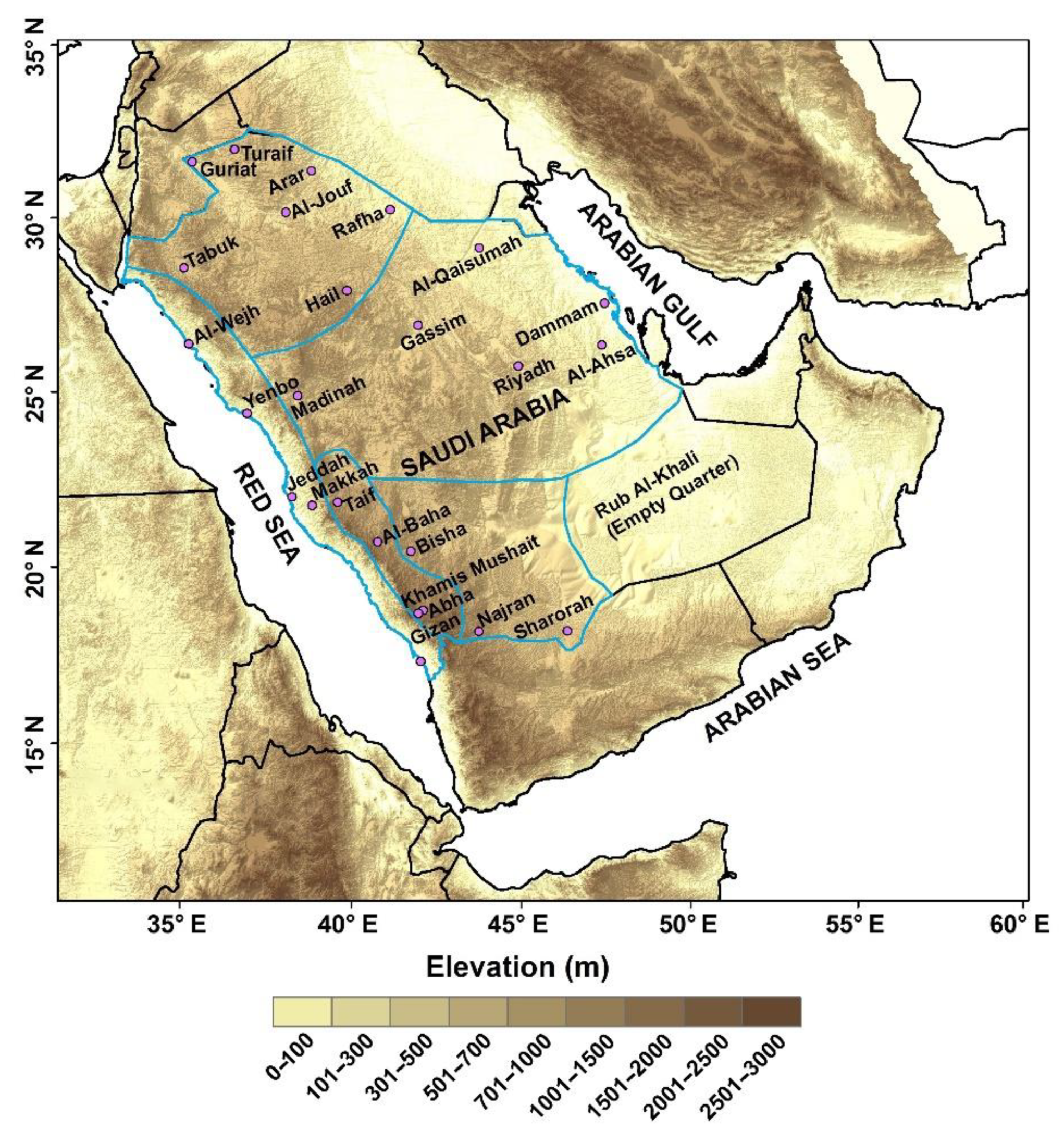
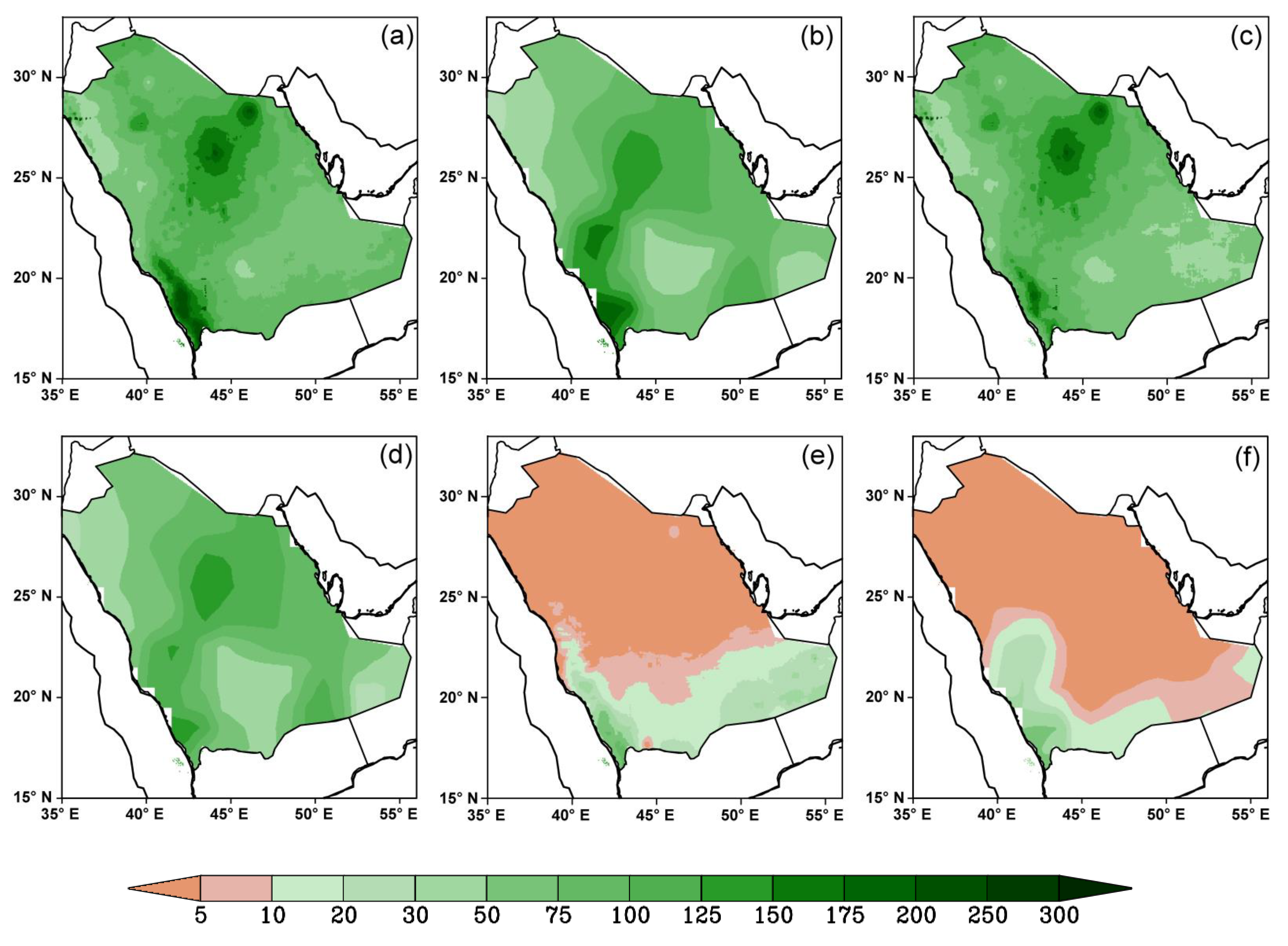
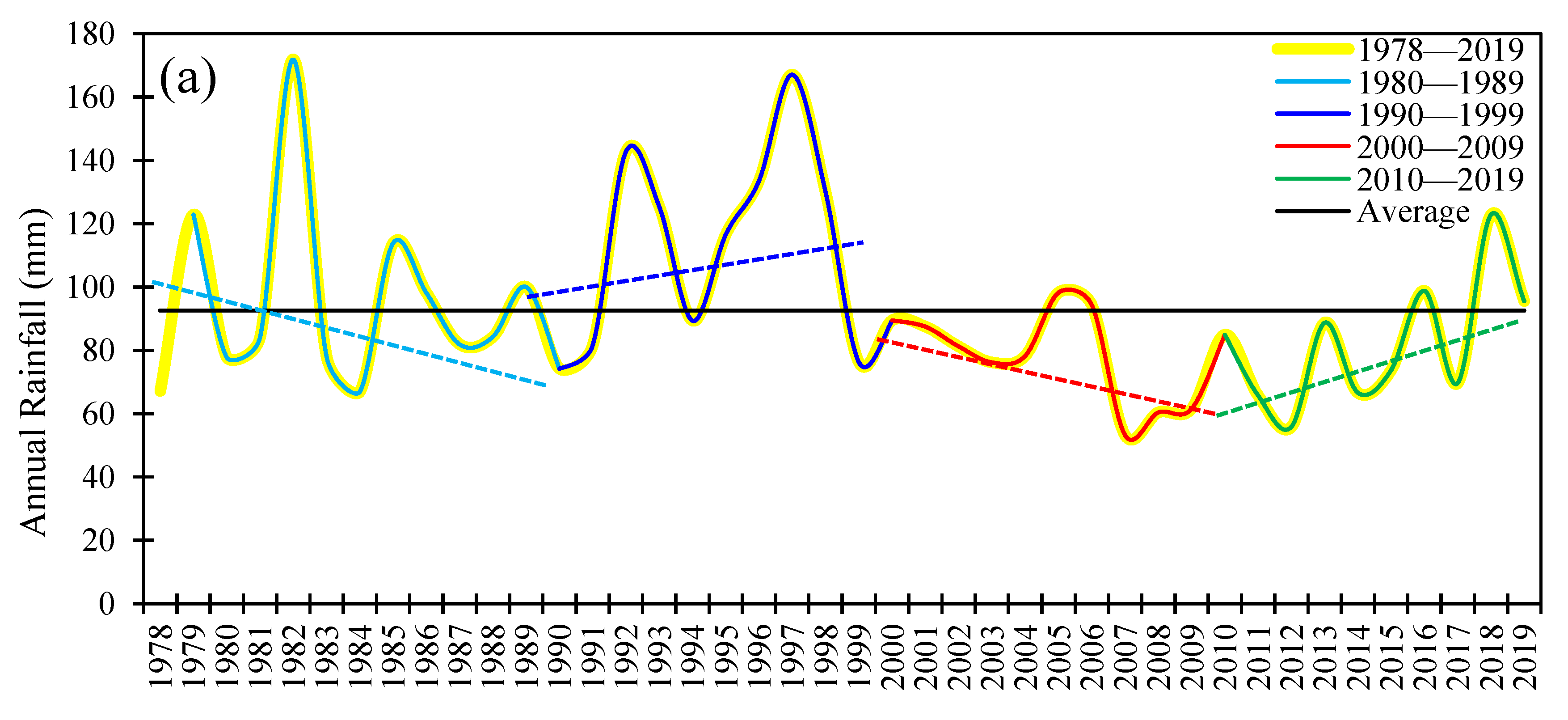
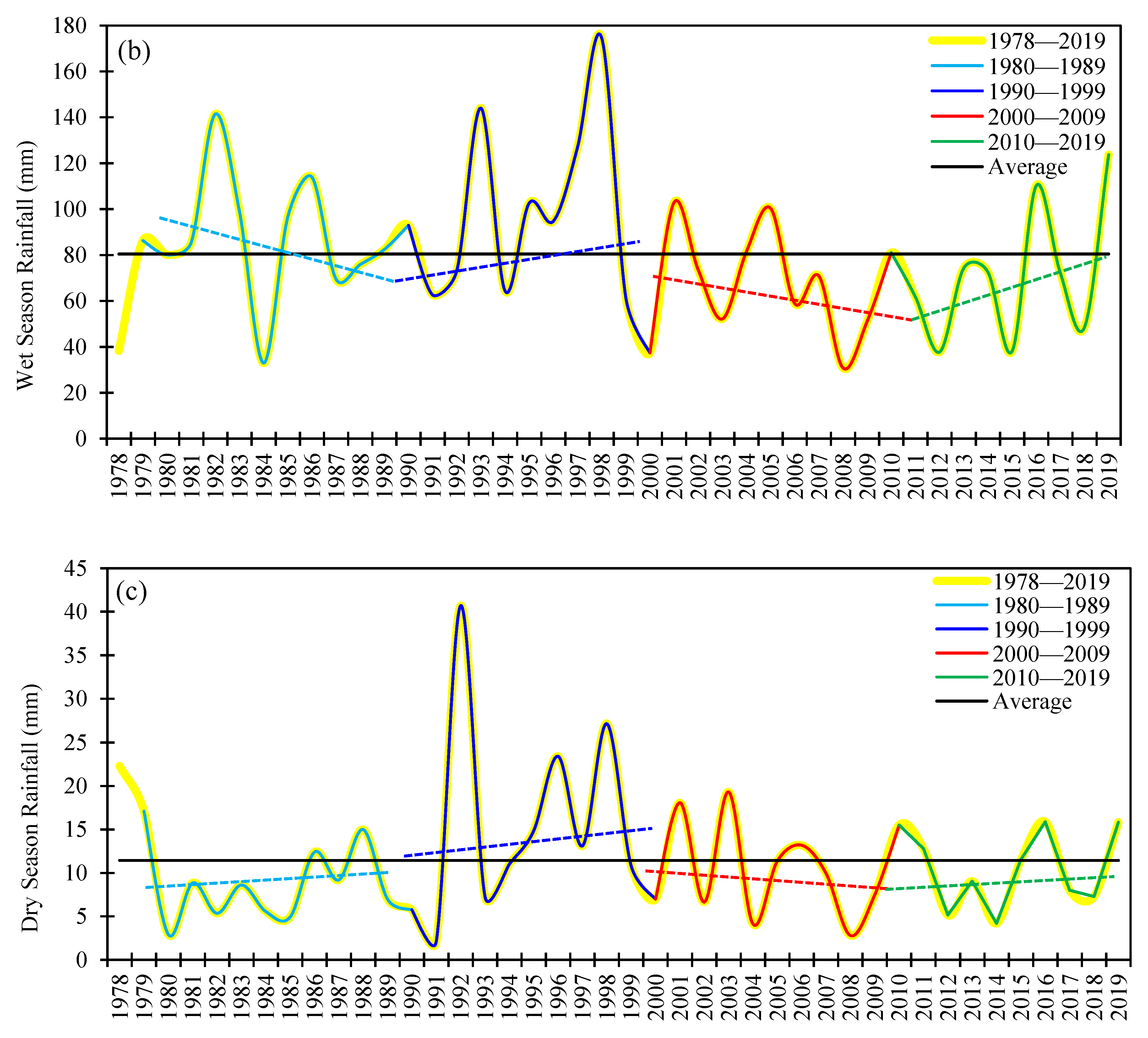
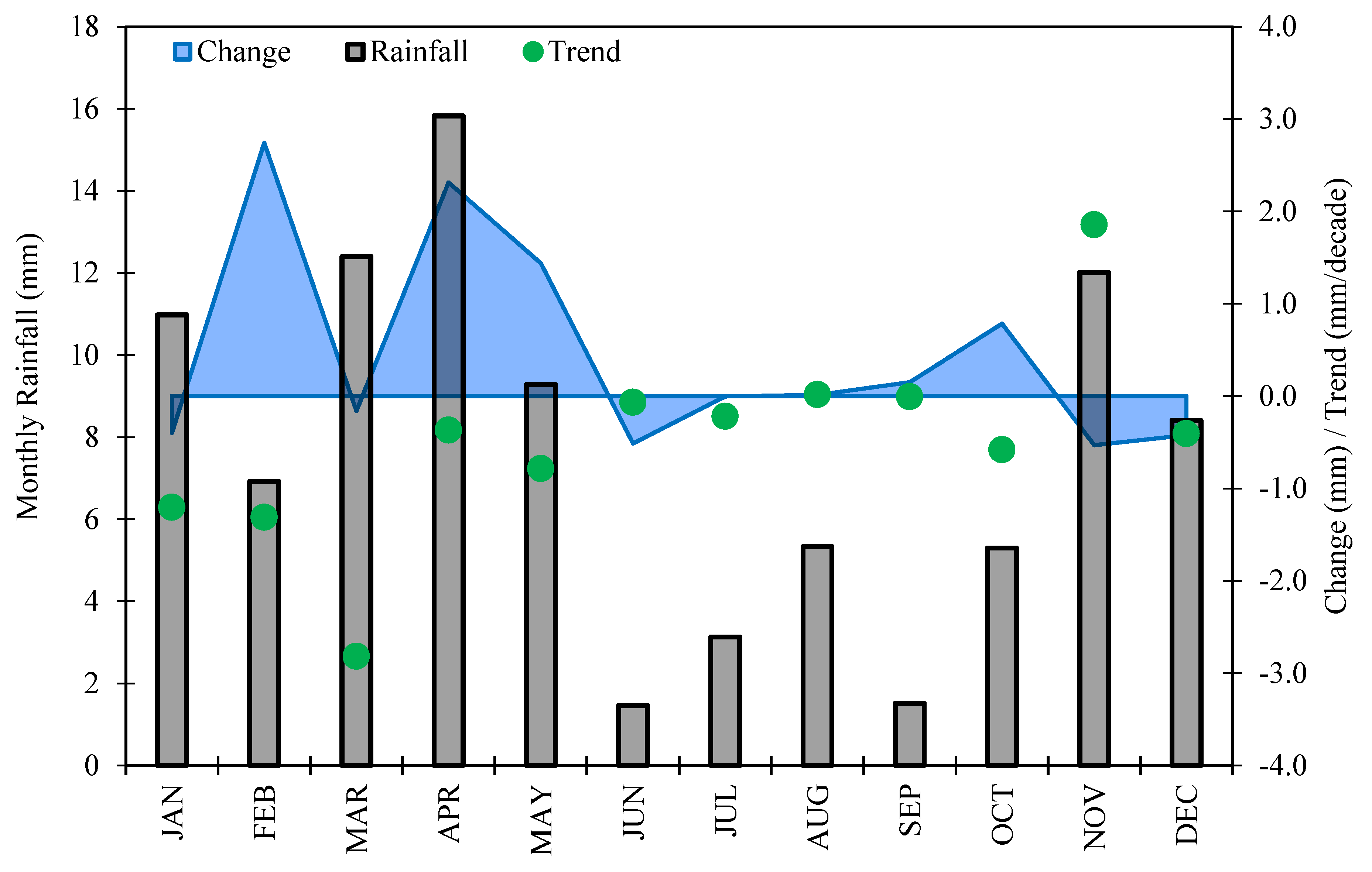
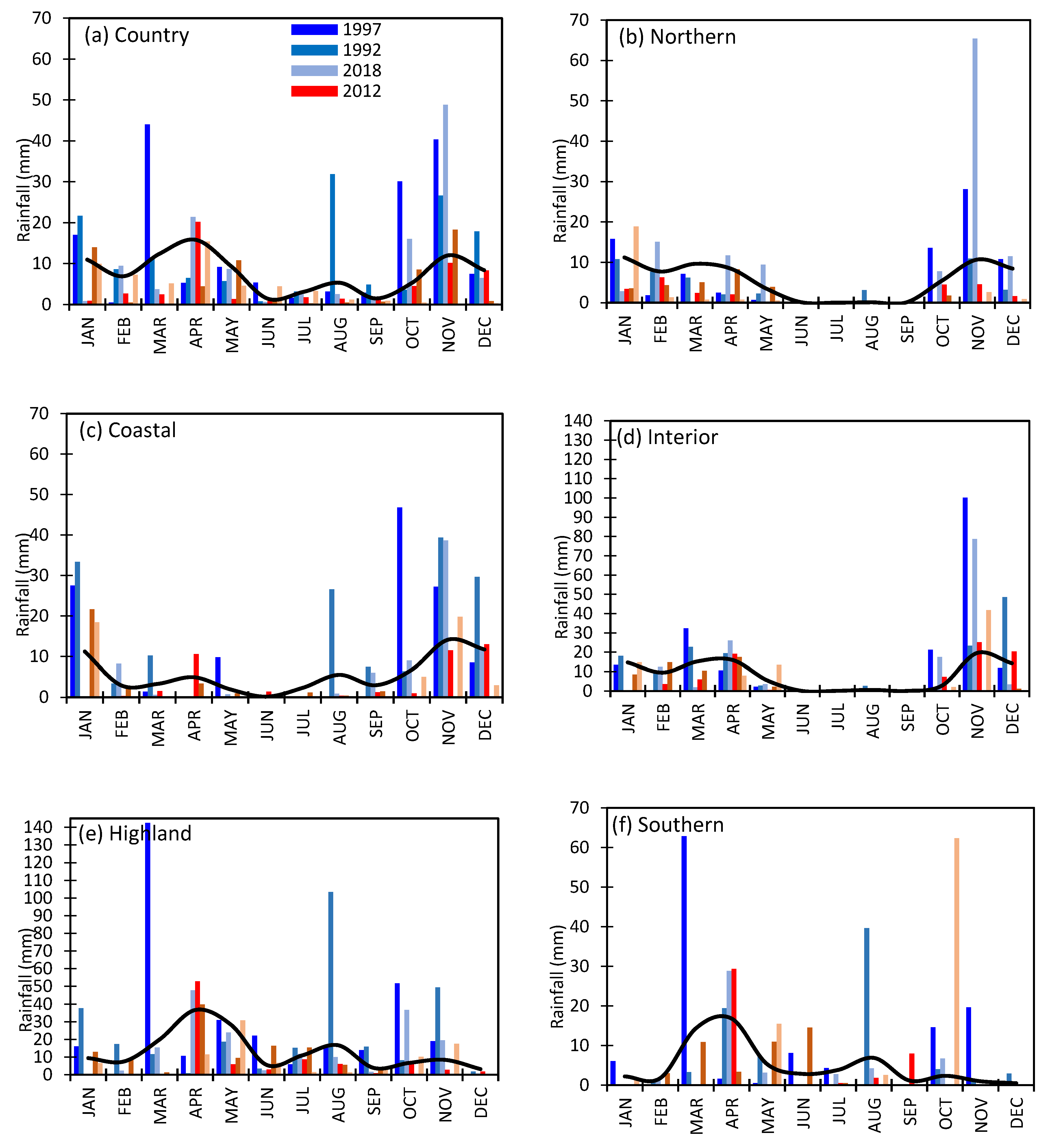
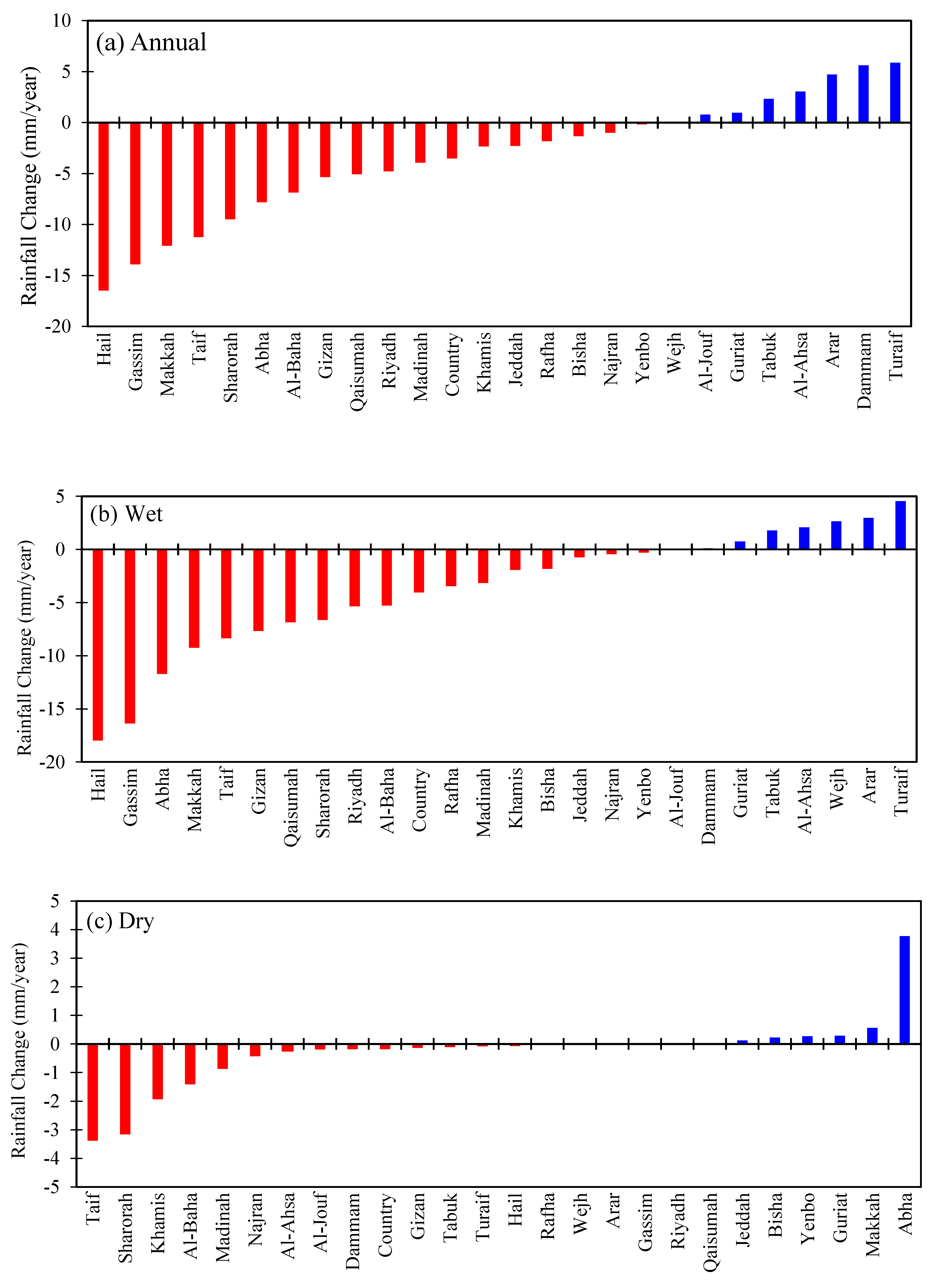


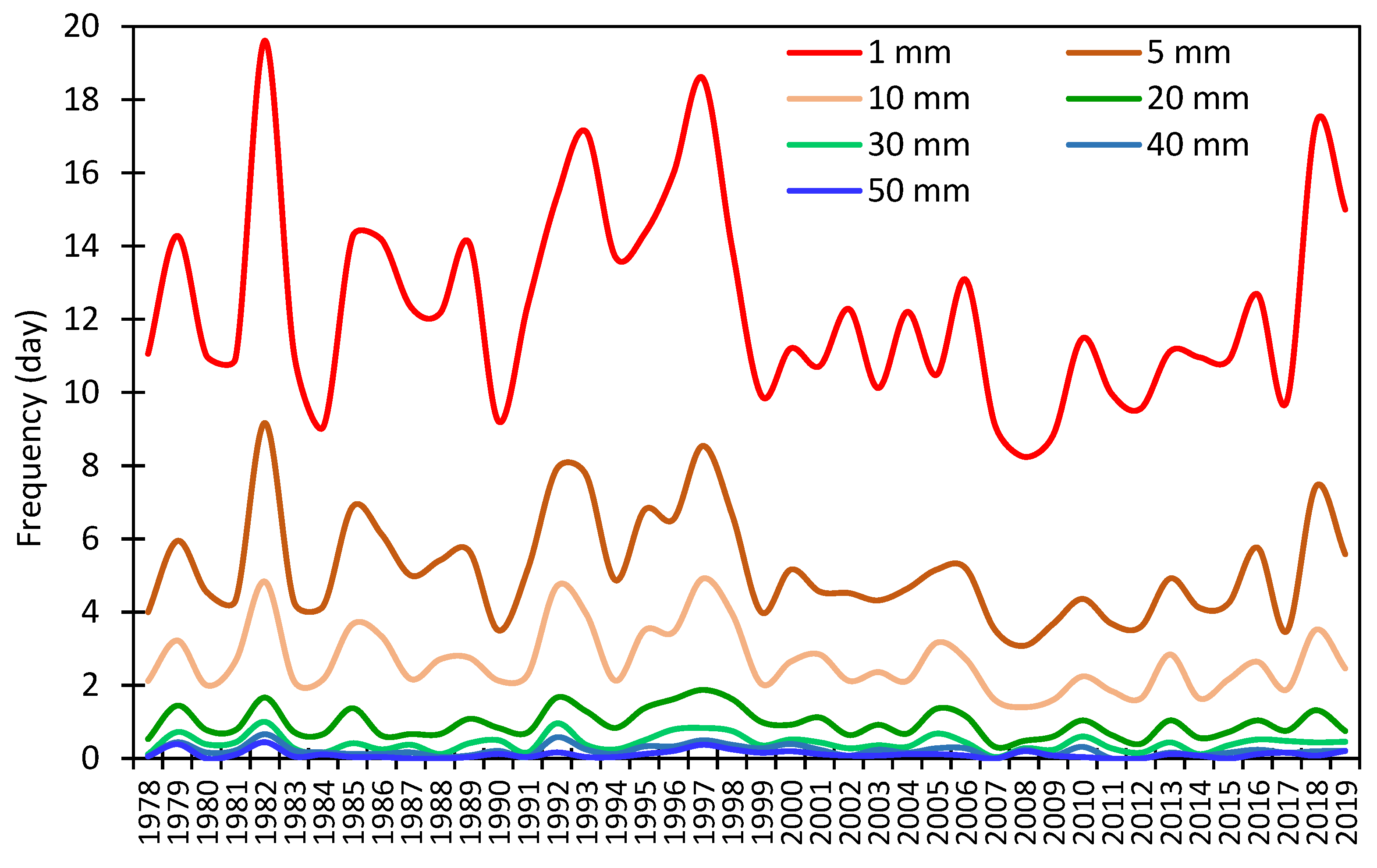
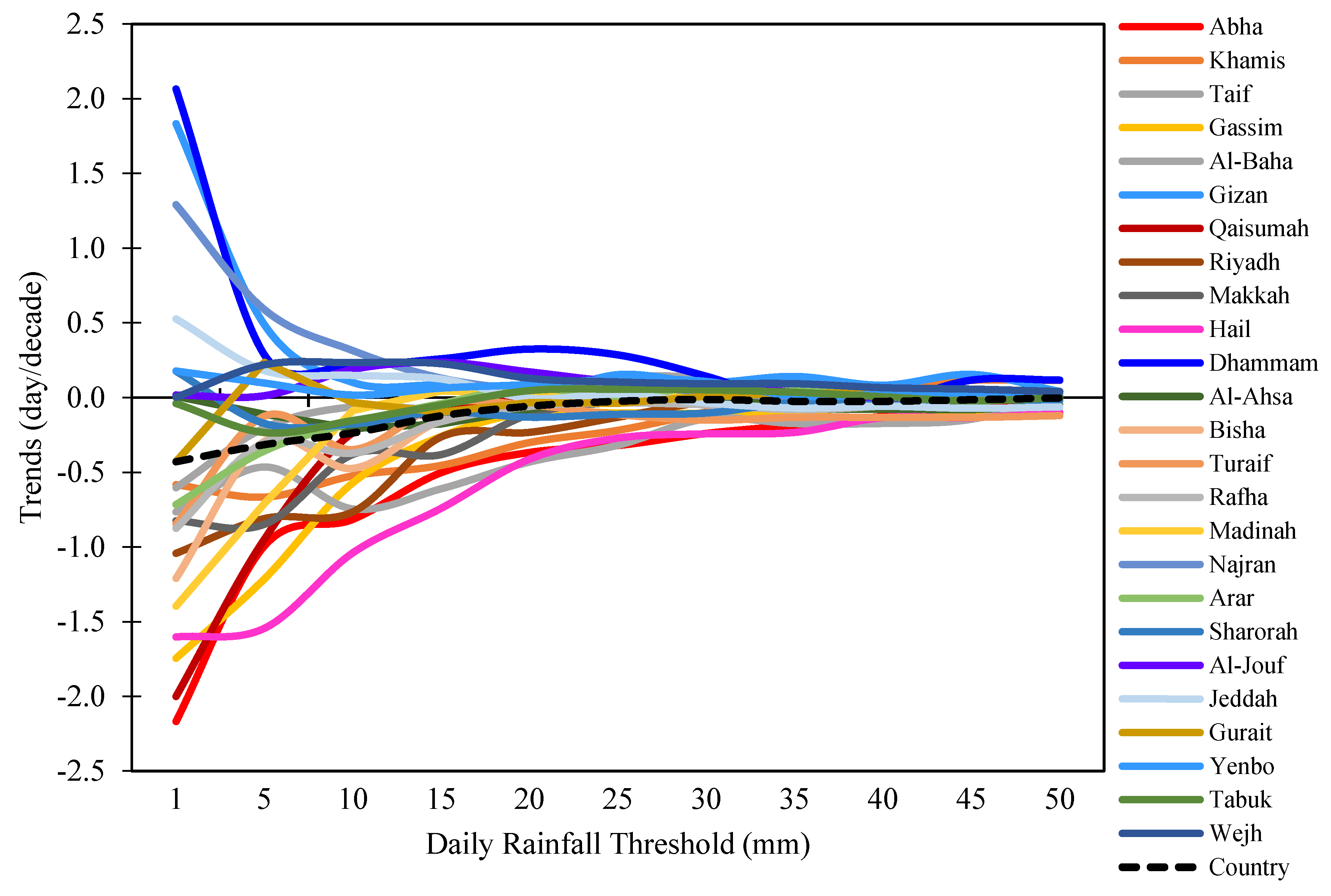

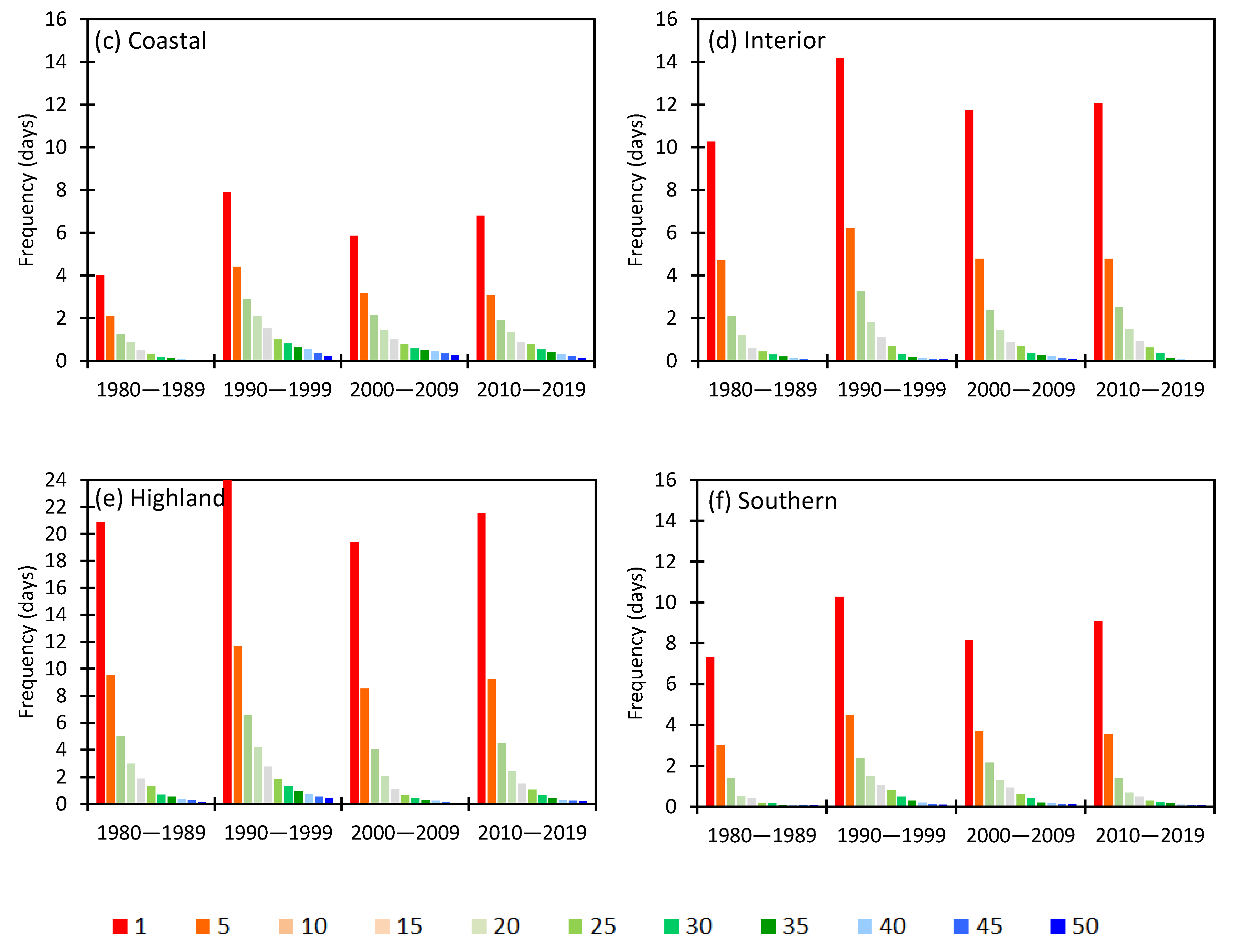
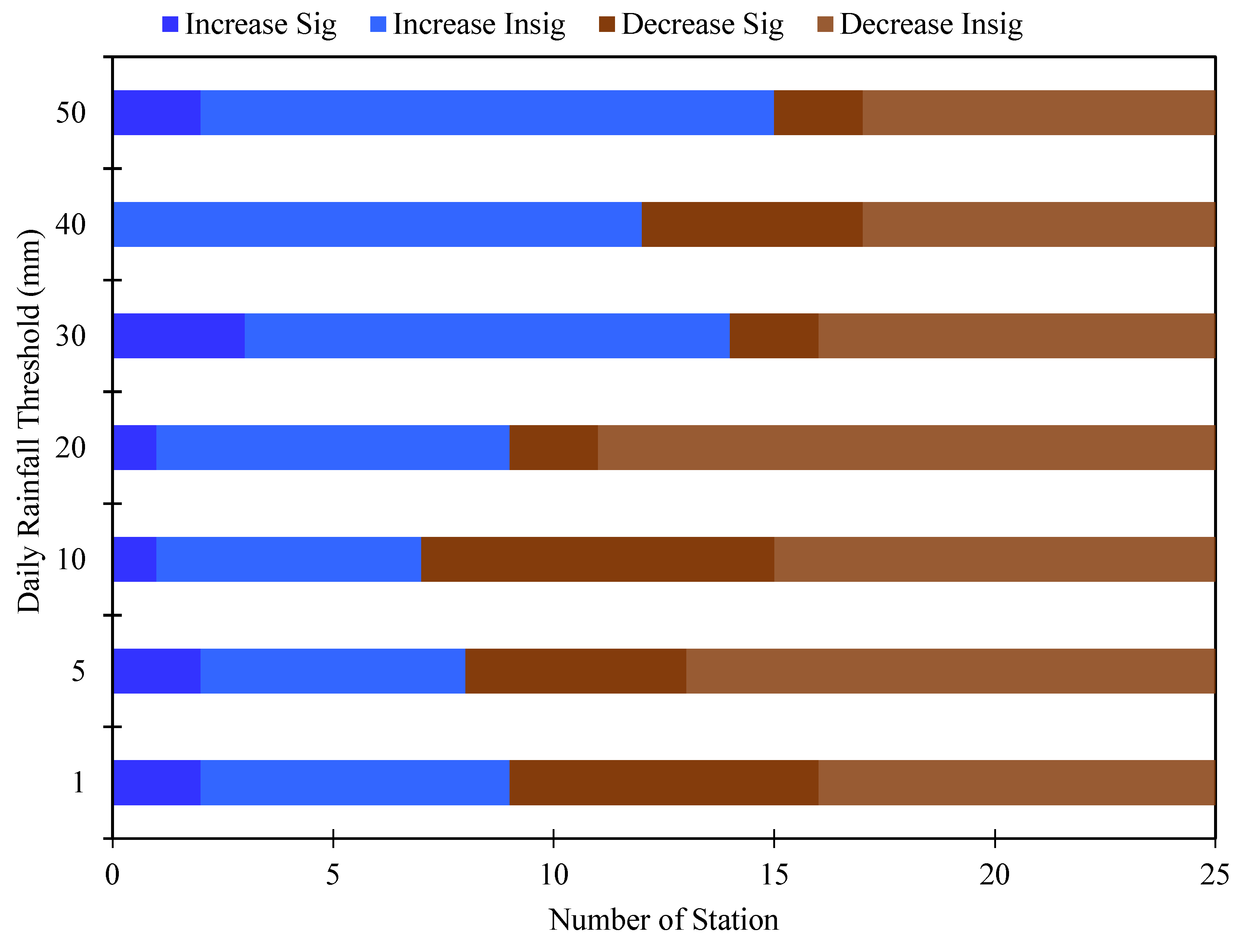
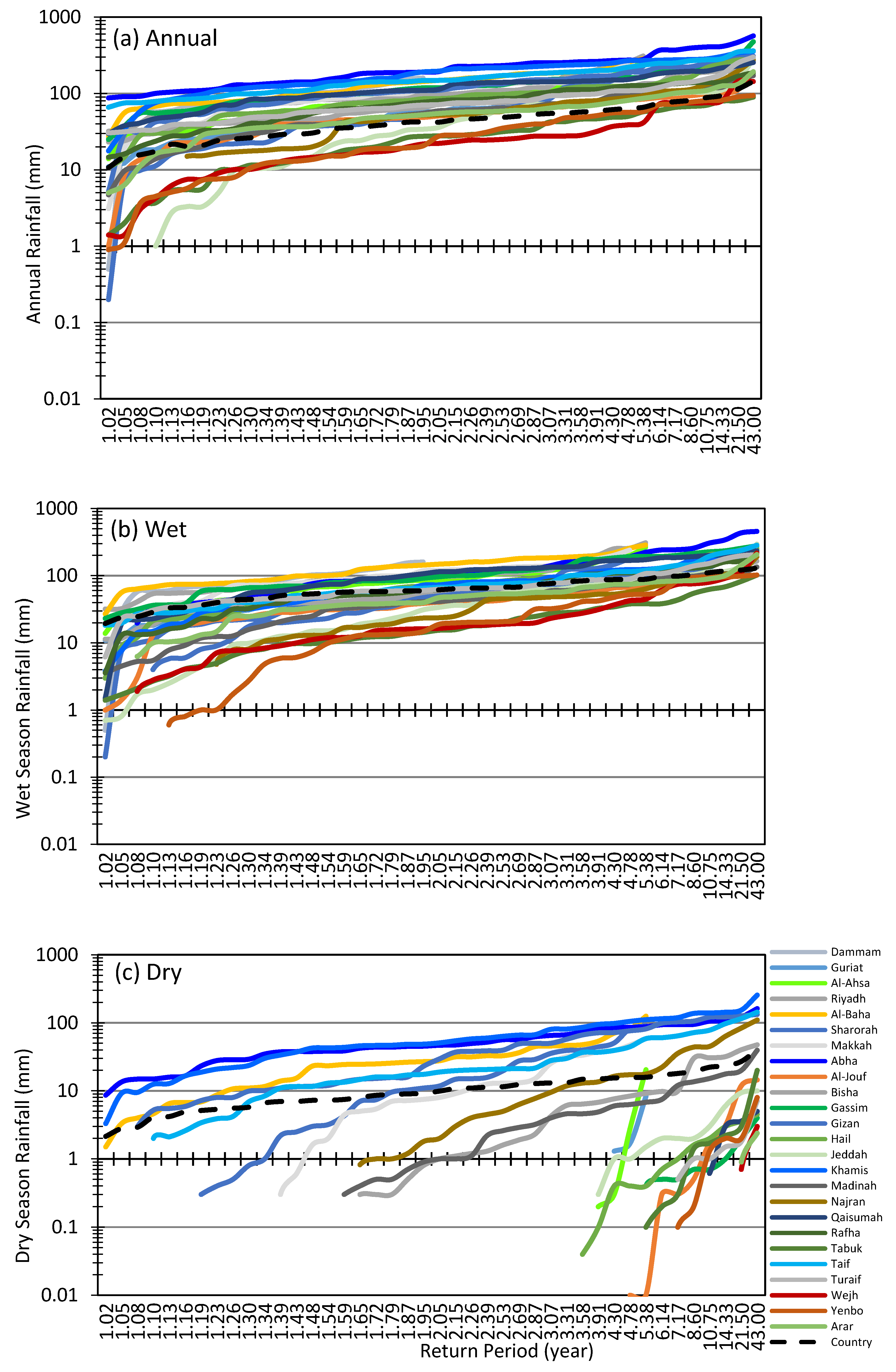
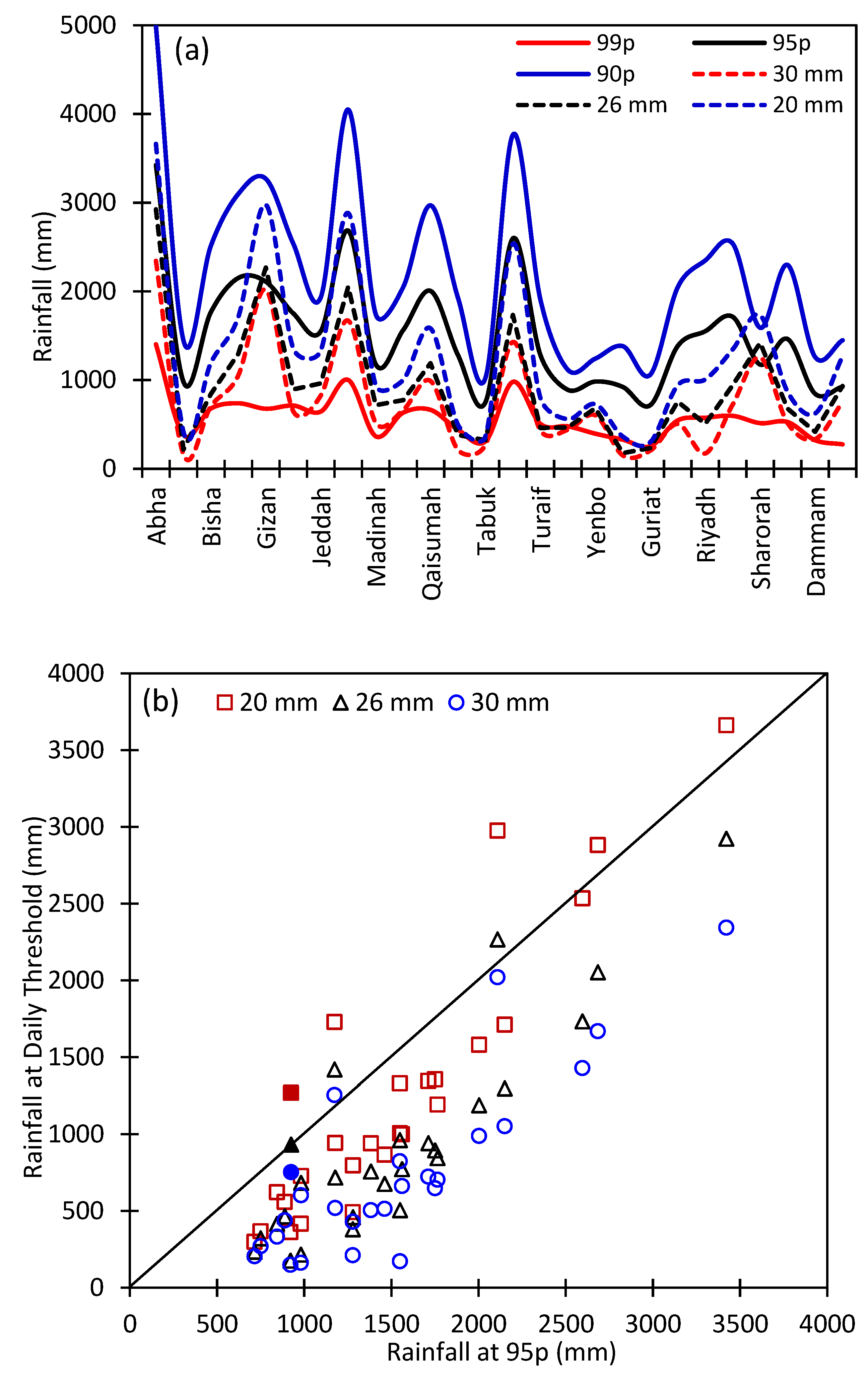
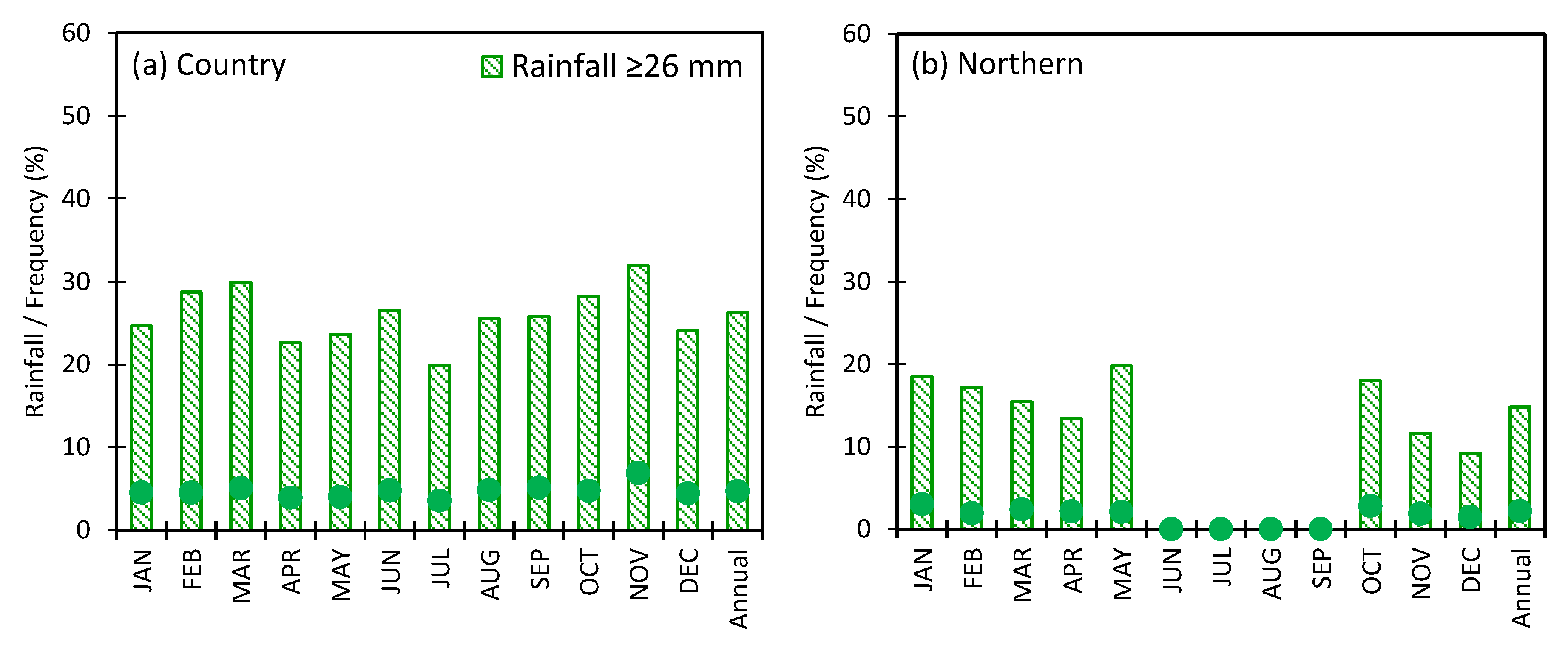

| Region | Sr. No. | Station Code | Station Name | Rainfall (mm) | Trend (mm Decade−1) | Lat. (N) | Lon. (E) | Elevation (m) | ||||
|---|---|---|---|---|---|---|---|---|---|---|---|---|
| Annual | Wet | Dry | Annual | Wet | Dry | |||||||
| Northern | 1 | 40375 | Tabuk | 31.4 | 30.3 | 0.7 | −2 c | −1 | 0 | 28.38 | 36.60 | 778 |
| 2 | 40356 | Turaif | 84.9 | 83.6 | 0.3 | −14 b | −13 b | 0 | 31.68 | 38.73 | 855 | |
| 3 | 40360 | Guriat * | 48.7 | 48.0 | 0.4 | 0 | 0 | 0 | 31.40 | 37.28 | 509 | |
| 4 | 40362 | Rafha | 80.6 | 79.4 | 0.1 | −7 | −7 | 0 | 29.62 | 43.48 | 449 | |
| 5 | 40357 | Arar | 59.7 | 58.4 | 0.1 | −3 | −3 | 0 | 30.90 | 41.13 | 555 | |
| 6 | 40361 | Al-Jouf | 56.1 | 55.0 | 0.8 | 5 | 7 | 0 | 29.78 | 40.10 | 689 | |
| 7 | 40394 | Hail | 97.4 | 96.5 | 0.4 | −30 a | −28 a | 0 | 27.43 | 41.68 | 1015 | |
| Interior | 8 | 40405 | Gassim | 131.3 | 130.2 | 0.2 | −19 c | −17 c | 0 | 26.30 | 43.77 | 648 |
| 9 | 40437 | Riyadh * | 105.5 | 104.9 | 0.0 | −14 | −12 | 0 | 24.93 | 46.72 | 614 | |
| 10 | 40373 | Al-Qaisumah | 120.7 | 119.9 | 0.3 | −11 c | −8 | 0 | 28.32 | 46.13 | 358 | |
| 11 | 40417 | Dammam | 87.4 | 88.9 | 0.2 | 16 | 9 | 0 | 26.45 | 49.82 | 22 | |
| 12 | 40420 | Al-Ahsa * | 86.5 | 84.6 | 0.7 | −3 | −2 | 0 | 25.30 | 49.48 | 179 | |
| 13 | 40430 | Madinah | 61.0 | 56.3 | 4.3 | −5 | −4 | 0 | 24.55 | 39.70 | 654 | |
| Coastal | 14 | 40400 | Al-Wejh | 31.1 | 31.0 | 0.1 | 6 | 7 | 0 | 26.20 | 36.48 | 20 |
| 15 | 40439 | Yenbo | 33.0 | 32.6 | 0.3 | 4 | 5 | 0 | 24.13 | 38.07 | 8 | |
| 16 | 41024 | Jeddah | 51.2 | 50.2 | 0.9 | 1 | 2 | 0 | 21.70 | 39.18 | 15 | |
| 17 | 41030 | Makkah * | 98.1 | 86.5 | 11.6 | −13 c | −8 | 1 | 21.43 | 39.77 | 240 | |
| 18 | 41140 | Gizan | 127.8 | 82.2 | 42.3 | 10 | 0 | 8 | 16.88 | 42.58 | 6 | |
| Highland | 19 | 41036 | Taif | 162.6 | 132.0 | 29.1 | −5 | −4 | −1 | 21.48 | 40.55 | 1478 |
| 20 | 41055 | Al-Baha * | 131.5 | 102.3 | 28.9 | −19 b | −11 | −7 c | 20.30 | 41.65 | 1672 | |
| 21 | 41114 | Khamis Mushait | 184.6 | 118.7 | 65.6 | −12 | −4 | −7 | 18.30 | 42.80 | 2066 | |
| 22 | 41112 | Abha | 221.2 | 165.3 | 55.7 | −25 c | −28 b | 4 | 18.23 | 42.65 | 2090 | |
| Southern | 23 | 41084 | Bisha | 86.4 | 79.8 | 6.2 | −8 | −6 | −2 | 19.98 | 42.63 | 1167 |
| 24 | 41128 | Najran | 60.3 | 47.4 | 12.9 | 9 | 7 | 2 | 17.62 | 44.42 | 1214 | |
| 25 | 41136 | Sharorah * | 57.8 | 41.0 | 16.6 | −4 | −3 | −1 | 17.47 | 47.10 | 720 | |
| Country | 92.5 | 80.5 | 11.4 | −6 c | −5 | 0 | ||||||
| Region | Station | 1 mm | 5 mm | 10 mm | 15 mm | 20 mm | 25 mm | 30 mm | 35 mm | 40 mm | 45 mm | 50 mm |
|---|---|---|---|---|---|---|---|---|---|---|---|---|
| Northern | Tabuk | −0.04 | −0.23 | −0.15 c | −0.05 | 0.05 | 0.06 | 0.05 | 0.03 | 0.00 | −0.02 | 0.00 |
| Turaif | −0.85 | −0.12 | −0.35 | −0.05 | −0.05 | −0.12 | −0.15 b | −0.13 b | −0.13 b | −0.13 b | −0.12 b | |
| Gurait | −0.43 a | 0.24 a | −0.03 | −0.10 | −0.03 | −0.04 | 0.01 | 0.03 | 0.04 | 0.00 a | 0.00 a | |
| Rafha | −0.88 | −0.30 | −0.37 c | −0.16 | −0.06 | −0.04 | −0.05 | −0.08 b | −0.06 c | 0.00 | 0.00 | |
| Arar | −0.72 | −0.36 | −0.17 | −0.04 | 0.07 | 0.00 | 0.08 b | 0.07 b | 0.03 | 0.00 | 0.00 | |
| Al-Jouf | 0.02 | 0.01 | 0.19 | 0.24 c | 0.17 b | 0.11 b | 0.10 a | 0.03 c | 0.00 | 0.00 | 0.00 | |
| Hail | −1.60 b | −1.54 a | −1.04 a | −0.74 a | −0.41 a | −0.27 a | −0.24 a | −0.23 a | −0.13 a | −0.13 a | −0.10 b | |
| Interior | Gassim | −1.74 b | −1.21 b | −0.57 c | −0.26 | −0.10 | −0.10 | −0.11 | −0.11 | −0.15 b | −0.10 c | −0.05 |
| Riyadh | −1.04 | −0.81 | −0.76 c | −0.26 | −0.23 | −0.13 | −0.03 | −0.02 | −0.02 | −0.02 | 0.00 | |
| Al-Qaisumah | −2.00 a | −0.95 b | −0.23 | −0.10 | 0.02 | 0.03 | 0.00 | 0.02 | 0.03 | −0.03 | −0.01 | |
| Dammam | 2.06 | 0.29 | 0.22 | 0.26 | 0.32 | 0.29 | 0.14 | −0.04 | −0.04 | 0.12 | 0.12 | |
| Al-Ahsa | 0.01 | −0.11 | −0.21 | −0.18 | −0.08 | 0.00 | 0.03 | −0.08 | −0.08 | −0.08 | −0.05 | |
| Madinah | −1.40 b | −0.71 b | −0.09 | 0.04 | 0.03 | 0.05 | 0.01 | 0.03 | 0.01 | 0.05 | 0.04 | |
| Coastal | Wejh | 0.00 | 0.22 | 0.23 c | 0.23 b | 0.13 | 0.10 | 0.09 | 0.09 | 0.07 | 0.06 | 0.04 |
| Yenbo | 0.18 | 0.10 | 0.02 | 0.06 | 0.09 | 0.12 c | 0.11 c | 0.01 | 0.02 | 0.03 | 0.03 | |
| Jeddah | 0.53 | 0.18 | 0.15 | 0.12 | −0.01 | 0.02 | −0.04 | −0.07 | −0.06 | −0.07 | −0.06 | |
| Makkah | −0.83 | −0.85 b | −0.38 | −0.38 c | −0.11 | −0.03 | −0.02 | 0.02 | 0.00 | −0.02 | 0.03 | |
| Gizan | 1.83 a | 0.49 | 0.10 | 0.08 | 0.01 | 0.15 | 0.10 | 0.14 | 0.08 | 0.15 | 0.04 | |
| Highland | Taif | −0.60 | −0.20 | −0.06 | −0.08 | −0.03 | 0.13 | 0.12 | −0.01 | −0.03 | −0.04 | −0.01 |
| Al-Baha | −0.76 | −0.46 | −0.75 c | −0.61 b | −0.43 b | −0.32 a | −0.14 | −0.17 b | −0.17 b | −0.15 c | 0.02 | |
| Khamis Mushait | −0.58 | −0.67 | −0.52 | −0.45 c | −0.30 | −0.22 | −0.10 | 0.03 | 0.08 | 0.12 | 0.12 c | |
| Abha | −2.17 a | −0.99 b | −0.82 b | −0.50 | −0.37 | −0.32 | −0.24 | −0.18 | −0.13 | −0.08 | −0.06 | |
| Southern | Bisha | −1.21 c | −0.29 | −0.47 c | −0.15 | −0.04 | −0.03 | 0.01 | 0.04 | −0.01 | −0.01 | −0.01 |
| Najran | 1.29 c | 0.59 c | 0.31 | 0.13 | 0.06 | 0.07 | 0.04 | 0.00 | 0.04 | 0.02 | 0.02 | |
| Sharorah | 0.18 | −0.17 | −0.18 | −0.10 | −0.13 | −0.11 | −0.10 | −0.03 | −0.03 | −0.02 | −0.02 | |
| Country | −0.43 | −0.32 c | −0.24 c | −0.12 | −0.06 | −0.02 | −0.01 | −0.02 | −0.03 | −0.01 | 0.00 |
© 2020 by the author. Licensee MDPI, Basel, Switzerland. This article is an open access article distributed under the terms and conditions of the Creative Commons Attribution (CC BY) license (http://creativecommons.org/licenses/by/4.0/).
Share and Cite
Almazroui, M. Rainfall Trends and Extremes in Saudi Arabia in Recent Decades. Atmosphere 2020, 11, 964. https://doi.org/10.3390/atmos11090964
Almazroui M. Rainfall Trends and Extremes in Saudi Arabia in Recent Decades. Atmosphere. 2020; 11(9):964. https://doi.org/10.3390/atmos11090964
Chicago/Turabian StyleAlmazroui, Mansour. 2020. "Rainfall Trends and Extremes in Saudi Arabia in Recent Decades" Atmosphere 11, no. 9: 964. https://doi.org/10.3390/atmos11090964
APA StyleAlmazroui, M. (2020). Rainfall Trends and Extremes in Saudi Arabia in Recent Decades. Atmosphere, 11(9), 964. https://doi.org/10.3390/atmos11090964






